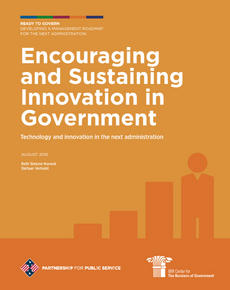
Encouraging and Sustaining Innovation in Government: Technology and Innovation in the Next Administration

Blog Co-Author: Haynes Cooney
How the next administration can effectively accelerate and integrate innovation throughout the federal government is the subject of a new report released jointly by the IBM Center for The Business of Government and the Partnership for Public Service. Encouraging and Sustaining Innovation in Government: Technology and Innovation in the Next Administration by Beth Simone Noveck and Stefaan Verhulst, proposes a series of actionable recommendations to create and sustain models for technology-driven innovation that improve customer services and program outcomes.
These recommendations emerged from a roundtable discussion held in January 2016 with current and former career and political government leaders, as well as experts from academia and the private and nonprofit sectors. The discussion highlighted that innovation is the means to an end, rather than an end-goal itself, and focused on how innovation can improve outcomes. As that discussion and today’s report demonstrates, effective integration of innovation into the next administration’s policy agenda will be key to rapid and successful achievement of policy goals.
The authors of this report built on the Roundtable discussion and their own work in and with governments on driving innovation to improve performance, to develop a number of actionable recommendations for the next Administration.
Scale data-driven governance and collaborative experiments. With a proliferation of open-data and data-driven governance initiatives over the past few years, the challenge facing the next administration lies in effectively analyzing this data to find meaningful operational insights and improvements. The next generation of innovation will come from the development of platforms, policies, and personnel that scale the capacity of the government to use available data meaningfully and efficiently to improve processes and services.
A commitment to scaling innovation includes not just analyzing data, but enabling greater use of available human intelligence. Improving effective citizen engagement -- from aligning thoughtful user experiences with agency missions, to addressing regulatory barriers and inflexibilities that limit engagement opportunities -- enabling diverse participation. Enterprise platforms have the potential to improve service delivery and expand opportunities while automating basic capabilities such as enrollment or eligibility calculations.
Promote a government-wide culture of innovation, experimentation, and customer service. The next administration can embrace experimentation, while embedding and institutionalizing innovation and technology skills across the federal government. These capabilities can be leveraged to apply an agency's own data to help them realize operational improvement and then measure those improvements. Federal institutions can become more transparent and use standard infrastructure and language to facilitate engagement and interaction, while creating more flexible hiring and training processes to accelerate the development of necessary skills in the government.
Become more evidence-based in using technology to solve problems. While the government has an array of advanced research programs, these capabilities could be directed more frequently to address government performance challenges. The next administration can establish and support a structured approach to apply these innovative research programs to the functioning of government. Additionally, federal oversight organizations can transform their focus to enable innovation.
Incorporate innovation into the transition. The transition period, which lasts through Jan 20, 2017, presents a powerful opportunity to drive innovation into substantive policy agendas and the delivery of services. Both at the government-wide and agency-specific levels, technology-enabled capabilities can be initiated during the transition to support the goals and priorities established by the new administration.
Incorporating technology and innovation early in transition planning will position the next administration to define meaningful, achievable, and scalable policy priorities and prepare for an effective first 100 days and beyond.
The report is part of a joint effort by the IBM Center for The Business of Government and the Partnership for Public Service to develop a Management Roadmap for the next administration. The Management Roadmap is a piece of the Partnership’s Center for Presidential Transition Ready to Govern initiative.



